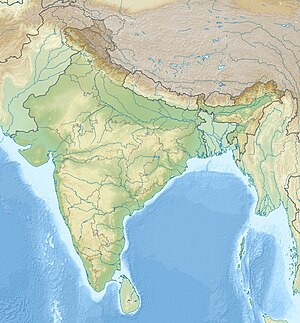Dudhkundi Airfield
| Dudhkundi Airfield | |
|---|---|
| Part of Twentieth Air Force Tenth Air Force |
|
| West Bengal, India | |
| Coordinates | 22°19′21.16″N 087°06′33.62″E / 22.3225444°N 87.1093389°ECoordinates: 22°19′21.16″N 087°06′33.62″E / 22.3225444°N 87.1093389°E |
| Type | Military airfield |
| Site information | |
| Condition | Abandoned |
| Site history | |
| Built | 1942 |
| In use | 1942-1945 |
| Battles/wars | World War II |
Dudhkundi Airfield is an abandoned airfield in India, located 12 miles (19.2 km) SE of Jhargram, in the Jhargram district district in the Indian state of West Bengal.
During World War II, the airfield hosted the United States Army Air Force 444th Bombardment Group prior to its deployment to the Mariana Islands.
Dudhkundi was originally designed for B-24 Liberator use. In 1943 it was designated as a B-29 Superfortress Base for the planned deployment of the United States Army Air Forces XX Bomber Command to India. Advance Army Air Forces echelons arrived in India in December 1943 to organize the upgrading of the airfield and thousands of Indians labored to upgrade the facility for Superfortress operations. It was one of four B-29 bases established by the Americans in India.
Finally ready for use in July 1944, the 444th Bombardment Group moved to Dudhkundi from Charra Airfield. The 444th was part of the Operation Matterhorn project of XX Bomber Command, the bombing of the Japanese Home Islands. In order to reach Japan, the B-29s of the group needed to stage operations from Kwanghan Airfield (A-3), a forward base just to the southwest of Chendu in south-central China.
However, all the supplies of fuel, bombs, and spares needed to support operations from Kwanghan had to be flown 1,200 miles from India over "The Hump" (the name given by Allied pilots to the eastern end of the Himalayan Mountains), since Japanese control of the seas around the Chinese coast made seaborne supply of China impossible. Many of the supplies had to be delivered to China by the B-29s themselves. For this role, they were stripped of nearly all combat equipment and used as flying tankers and each carried seven tons of fuel for the six-hour (one way) flight, which itself was almost at the limit of the B-29's range. The Hump route was so dangerous and difficult that each time a B-29 flew from India to China it was counted as a combat mission. It took six round-trip flights by each Superfortress to Kwanghan in order to mount one combat mission from the forward base.
...
Wikipedia



